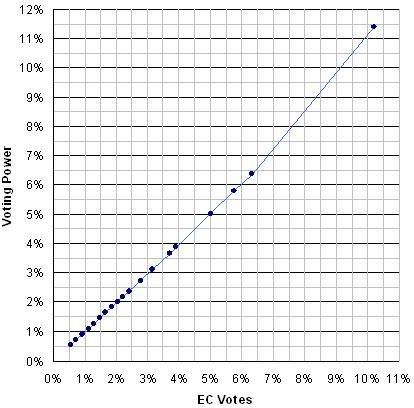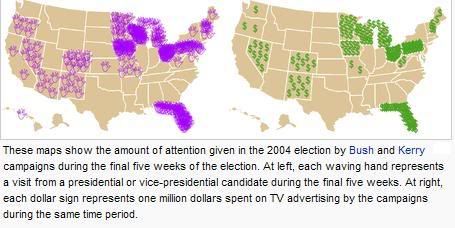There are a few quite good articles that discuss the pros and cons of the Electoral College system better than I could.
http://www.uselectionatlas.org/INFORMAT ... procon.php
http://usinfo.state.gov/journals/itdhr/ ... ulness.htm
http://en.wikipedia.org/wiki/U.S._Elect ... al_College
http://en.wikipedia.org/wiki/U.S._Elect ... al_College
So in summary the presidential election was never designed to be a popular vote (one leg of the ‘checks and balances’ does that – sort of) but a mechanism to garner wide support across diverse geographical areas.
Never mind the election now being dominated by swing states now as opposed to urban areas, I did some analysis on the 2008 results. Oh boy does the present system come at a cost!
In the numbers below:
EC = the number of Electoral College votes
Voters = the number of registered voters as at 2004 – the latest reliable source (http://www.statemaster.com/graph/gov_20 ... red-voters)
Republican / Democrat = the number of votes cast (as of now)
EC Weighting = (Electoral College votes) / (Registered voters), compared with the national average. So in Wyoming a voter has in effect 3 times the effective strength compared with the US as a whole. Wisconsin has the weakest.
Code: Select all
State EC Voters Republican Democrat EC Weighting
Alabama 9 2,418,000 1,264,879 811,764 0.98
Alaska 3 334,000 136,585 80,505 2.37
Arizona 10 2,485,000 1,131,790 948,066 1.06
Arkansas 6 1,328,000 632,672 418,049 1.19
California 55 14,193,000 4,144,693 6,765,199 1.02
Colorado 9 2,307,000 1,020,135 1,216,793 1.03
Connecticut 7 1,695,000 614,584 973,302 1.09
Delaware 3 415,000 152,356 255,394 1.91
Florida 27 8,219,000 3,939,380 4,143,957 0.87
Georgia 15 3,948,000 2,048,244 1,843,452 1.00
Hawaii 4 497,000 120,309 324,918 2.13
Idaho 4 663,000 400,989 235,219 1.59
Illinois 21 6,437,000 1,975,801 3,293,340 0.86
Indiana 11 3,031,000 1,341,667 1,367,503 0.96
Iowa 7 1,674,000 677,508 818,240 1.10
Kansas 6 1,338,000 685,541 499,979 1.18
Kentucky 8 2,231,000 1,050,599 751,515 0.95
Louisiana 9 2,413,000 1,147,603 780,981 0.98
Maine 4 824,000 296,195 421,484 1.28
Maryland 10 2,676,000 938,671 1,579,890 0.99
Massachusetts 12 3,483,000 1,104,284 1,891,083 0.91
Michigan 17 5,364,000 2,044,405 2,867,680 0.84
Minnesota 10 3,080,000 1,275,400 1,573,323 0.86
Mississippi 6 1,510,000 687,266 520,864 1.05
Missouri 11 3,336,000 1,444,289 1,439,321 0.87
Montana 3 519,000 241,816 229,725 1.53
Nebraska 5 918,000 446,039 324,352 1.44
Nevada 5 965,000 411,988 531,884 1.37
New Hampshire 4 716,000 316,937 384,591 1.48
New Jersey 15 4,085,000 1,545,495 2,085,051 0.97
New Mexico 5 936,000 343,820 464,458 1.41
New York 31 8,624,000 2,576,360 4,363,386 0.95
North Carolina 15 4,292,000 2,109,698 2,123,390 0.92
North Dakota 3 412,000 168,523 141,113 1.92
Ohio 20 6,003,000 2,502,218 2,708,988 0.88
Oklahoma 7 1,781,000 959,745 502,294 1.04
Oregon 7 2,049,000 699,673 978,605 0.90
Pennsylvania 21 6,481,000 2,586,496 3,192,316 0.86
Rhode Island 4 522,000 157,317 281,209 2.02
South Carolina 8 2,238,000 1,034,500 862,042 0.94
South Dakota 3 425,000 203,019 170,886 1.86
Tennessee 11 2,739,000 1,487,564 1,093,213 1.06
Texas 34 9,681,000 4,467,748 3,521,164 0.93
Utah 5 1,141,000 555,497 301,771 1.16
Vermont 3 354,000 96,458 203,952 2.24
Virginia 13 3,441,000 1,726,053 1,958,370 1.00
Washington 11 3,133,000 1,098,072 1,548,654 0.93
Washington, D.C. 3 293,000 14,821 210,403 2.70
West Virginia 5 935,000 394,278 301,438 1.41
Wisconsin 10 3,225,000 1,258,181 1,670,474 0.82
Wyoming 3 265,000 160,639 80,496 2.99
Total 538 142,072,000 57,838,800 66,056,046 1.00
OK, a bunch of numbers. What does it tell us?
First Past The Post
Firstly, the first past the post system where winner takes all in each state is deeply flawed. Only Maine and Nebraska use a form of proportional representation. In California over 4m people voted Republican but were not represented by any EC delegate. Across the country it added up to 52.3m people being effectively disenfranchised. That’s 42% of the people who voted. In the infamous 2000 election it was 'only' 47.7m people, but that represented 47.0% of all who voted.
Over 40% of the electorate disenfranchised? Whatever the pros and cons of the system, this is too much of a con, in more than one sense of the word.
Of course, there is a systematic flaw in the concept. Technically, and I stress technically, you could have had 11 people vote for one candidate (one in each of the 11 biggest states with no other vote cast), and over 64.7m vote for the other candidate in all the other States – and the 11 people would have won. Somewhat a reduction ad absurdum approach since it simply wouldn’t happen in real life, but it seems strange to have a system where technically it could.
We all know that in 2000 if just 500 voters had voted differently (Florida), Gore would have won the election. What about this year? Well, the minimum number of voters it would have required to vote differently for McCain to have won is just 604,000 - Colorado, Florida, Indiana, Iowa, New Hampshire, New Mexico, North Carolina, Ohio and Virginia. A majority of the EC, but only 47.7% of the popular vote. If instead of pure votes, we go by easiest swings – ie marginal seats – it’s not that much more. Only 694,000 votes – take New Mexico out of the list and replace it with Minnesota. This time that’s a whopping 47.8% of the popular vote.
Proportional Representation
If each state had apportioned the EC proportionally, Obama would have received 288 EC votes (53.5%) compared with 53.3% of the popular vote. Pretty close considering there is weighting for each state. And what about the 2000 election? Well no candidate would have received a majority (and Nadar would have received 7), it would have gone to the House of Representatives which was Republican at the time so Bush still would have won. Even taking the third party candidates out and apportioning the EC votes based purely on Rep / Dem votes incredibly it would have been a tie (269-269) and would again have gone to the House of Representatives.
Interesting to see that in both years, despite different weightings given to different states, using proportional representation within each state is very close to the overall popular vote.
Rural weighting
I did wonder if the weighting towards rural areas automatically skewed the EC in favour of the Republicans. Rural areas, with the population more spread out, tend to be more self-sufficient, less ‘community-minded’ and therefore tend to lean more to the Republicans. A simple analysis shows there is no significant correlation between the EC weighting and the Republican % in both 2008 and 2000 – even after taking out the anomalous Washington DC.
Of course, the US Senate, since it is just two per state no matter what the population in the state, has even more of a rural weighting and so is even worse.
I make no comment about using such weightings other than to say, well, it feels wrong. I reserve the right to form a more considered opinion later!
Voting Power
I did wonder whether the weightings gave even more power than one might initially think to any one state. Consider the following hypothetical: the US is made up of just two states, Virginia (3,441,000 voters and 13 EC votes from the above table) and Massachusetts (3,483,000 voters and 12 EC votes). Although the latter has more voters, it has no voting power whatsoever since whatever the Virginia voters decide will end up with the majority of the EC votes (13 out of 25). The voting power is Virginia 100% (13 votes), Massachusetts 0% (12 votes).
Let’s add another state into the mix – Rhode Island (522,000 voters and 4 EC votes). This time Virginia has a say in the matter, but no more than the other two! Any combination of two out of the three will produce a majority. The voting power is now Virginia 33% (13 votes), Massachusetts 33% (12 votes), and Rhode Island 33% (4 votes).
So how does it look like for all of the US? Well I ran the model and it turns out that there is no undue influence as a result. In fact the correlation between electoral votes and voting power is 99.8%. Only California has any meaningful voting power over and above the votes (11.4% of the power, 10.22% of the votes).

Conclusion
The Electoral College system certainly needs a fresh rethink. Personally, I’d go with proportional representation within each state, albeit a more direct version than that in Maine and Nebraska. As to the disproportionate weighting by state as a whole, I still have to think about that.



